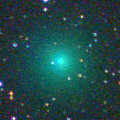
|
Now it is bright as 8.1 mag (Apr. 6, Juan Jose Gonzalez). It keeps 9-10 mag for a while until July. In the Northern Hemisphere, it is observable in the low sky both in the morning and evening in mid April. It will be observable in the evening low sky from late April to mid May. It will be unobservable after that. But it will appear in the morning sky again at 12 mag in late August, then it will be fading slowly in the low sky. In the Southern Hemisphere, it is not observable until August. But it keeps observable in good condition for a long time after August.
Date(TT) R.A. (2000) Decl. Delta r Elong. m1 Best Time(A, h)
Apr. 18 1 33.59 56 36.3 1.791 1.308 45 8.9 3:55 (210, 15)
Apr. 25 2 30.57 55 38.5 1.832 1.289 42 8.9 20:11 (149, 15)
|
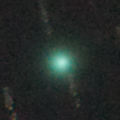
|
It brightened rapidly, and it reached up to 7.5 mag on Apr. 5 (Juan Jose Gonzalez). Now it is not observable, but it will appear in the morning sky at 10 mag in late April. Ten it keeps observable in good condition while fading. In the Southern Hemisphere, it had been locating in good position until discovered in mid March, however, now it is not observable. It will appear in the morning sky in late May when it fades down to 13 mag.
Date(TT) R.A. (2000) Decl. Delta r Elong. m1 Best Time(A, h)
Apr. 18 1 21.25 29 35.0 1.490 0.639 19 9.0 3:55 (232, -1)
Apr. 25 1 4.57 30 24.3 1.512 0.705 22 9.9 3:44 (236, 5)
|
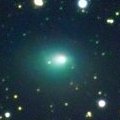
|
Brightening very rapidly, faster than expected. It is already so bright as 9.3 mag (Apr. 6, Juan Jose Gonzalez). It is expected to reach to 8 mag in 2009 summer. Although it had been low for a while, it is getting higher after this, and it will be observable at 8-10 mag in good condition for a long time until late autumn.
Date(TT) R.A. (2000) Decl. Delta r Elong. m1 Best Time(A, h)
Apr. 18 22 50.81 34 6.1 3.839 3.220 45 9.3 3:55 (246, 28)
Apr. 25 22 51.89 34 15.9 3.766 3.205 49 9.2 3:44 (247, 31)
|
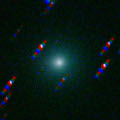
|
Now it is bright as 9.6 mag (Apr. 11, Marco Goiato). It keeps 10 mag until June. In the Northern Hemisphere, it is visible in the morning low sky now. However, it moves southwards very quickly. It is only observable until the end of April, and it will never be observable again after May. In the Southern Hemisphere, it keeps observable in a good condition for a long time.
Date(TT) R.A. (2000) Decl. Delta r Elong. m1 Best Time(A, h)
Apr. 18 22 49.22 -5 24.1 1.557 1.129 46 10.0 3:55 (282, 7)
Apr. 25 23 3.95 -10 15.6 1.441 1.137 51 9.9 3:44 (286, 5)
|
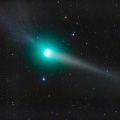
|
It passed near by the earth in late February, and it reached up to 4.9 mag (Feb. 23, Juan Jose Gonzalez). The coma extended up to 20 arcmin, and the anti-tail was clearly visible. Now it is fading rapidly. It has already faded down to 9.0 mag (Apr. 10, Marco Goiato). Because moving along the retrograde orbit, it will be lower rapidly in the evening sky. It will be too low to observe at 12 mag in late May.
Date(TT) R.A. (2000) Decl. Delta r Elong. m1 Best Time(A, h)
Apr. 18 6 35.17 22 24.2 1.978 1.890 70 10.0 20:04 ( 87, 46)
Apr. 25 6 34.68 22 24.0 2.201 1.965 63 10.4 20:11 ( 92, 38)
|
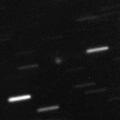
|
Now it is 9.7 mag, already so bright (Apr. 6, Juan Jose Gonzalez). It will be bright at 9-10 mag for a long time from spring to autumn.
Date(TT) R.A. (2000) Decl. Delta r Elong. m1 Best Time(A, h)
Apr. 18 20 2.98 -16 34.6 1.299 1.622 88 10.3 3:55 (320, 28)
Apr. 25 20 21.98 -15 46.1 1.240 1.607 90 10.1 3:44 (319, 29)
|
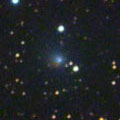
|
It has already brighted up to 10.5 mag (Apr. 11, Willian Souza). It will reach to 9 mag in June. In the Northern Hemisphere, it keeps observable in good condition until May, but it will never be observable again after that. In the Southern Hemisphere, it keeps observable for a long time after this in the evening sky.
Date(TT) R.A. (2000) Decl. Delta r Elong. m1 Best Time(A, h)
Apr. 18 5 36.85 34 15.1 1.748 1.481 57 10.3 20:04 (108, 39)
Apr. 25 5 53.39 30 28.7 1.756 1.423 54 10.1 20:11 (106, 34)
|
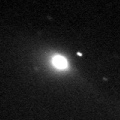
|
It has brightened very rapidly, faster than expected. Now it is so bright as 9.7 mag (Apr. 5, Marco Goiato). It will be fading gradually after this. It will be too low to observe in the evening at 13 mag in late June.
Date(TT) R.A. (2000) Decl. Delta r Elong. m1 Best Time(A, h)
Apr. 18 4 43.07 26 26.0 1.893 1.380 44 11.0 20:04 (106, 25)
Apr. 25 5 10.67 27 20.9 1.948 1.417 44 11.2 20:11 (107, 24)
|
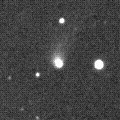
|
It has already brightened up to 10.5 mag (Apr. 11, Alexandre Amorim). It is expected to brighten up to 10 mag from late 2009 to early 2010. Good condition in the Southern Hemisphere. In the Northern Hemisphere, it is observable in the evening low sky from February to April. Then it becomes unobservable until September. But after October, it is observable at 10 mag for a while in good condition. In the Southern Hemisphere, it keeps observable for a long time while brightening until June when it brightens to 11 mag. But it becomes unobservable around and after the brightest time.
Date(TT) R.A. (2000) Decl. Delta r Elong. m1 Best Time(A, h)
Apr. 18 6 0.09 -22 29.2 3.132 2.961 70 11.5 20:04 ( 53, 11)
Apr. 25 6 9.25 -20 12.4 3.145 2.913 67 11.4 20:11 ( 59, 8)
|
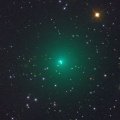
|
It brightened much faster than expected, and reached up to 8.4 mag (Jan. 30, Juan Jose Gonzalez). It was very large and visible through binoculars. It will be fading after this, but still bright as 9.3 mag (Mar. 26, Juan Jose Gonzalez). It keeps locating high in the evening sky for a while. It keeps higher than 40 degree until mid May when it fades down to 14 mag.
Date(TT) R.A. (2000) Decl. Delta r Elong. m1 Best Time(A, h)
Apr. 18 7 56.11 15 33.8 1.368 1.697 90 12.2 20:04 ( 60, 58)
Apr. 25 8 14.53 14 49.6 1.457 1.737 87 12.6 20:11 ( 64, 54)
|

|
It brightened up to 9.8 mag in December and January (Dec. 28, Juan Jose Gonzalez). Now it is fading, but still bright as 11.5 mag (Mar. 26, Juan Jose Gonzalez). It keeps visible visually for a long time until June when it becomes low in the evening at 13 mag.
Date(TT) R.A. (2000) Decl. Delta r Elong. m1 Best Time(A, h)
Apr. 18 6 59.14 33 2.5 3.460 3.341 74 12.5 20:04 ( 99, 55)
Apr. 25 7 7.66 31 58.7 3.600 3.390 69 12.6 20:11 (100, 49)
|
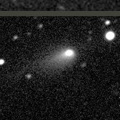
|
Now it is very bright as 11.5 mag (Mar. 26, Juan Jose Gonzalez). It keeps observable in good condition until May, then it keeps observable until July when it becomes too low in the evening sky, around 12-13 mag for a long time.
Date(TT) R.A. (2000) Decl. Delta r Elong. m1 Best Time(A, h)
Apr. 18 9 25.22 18 17.3 1.722 2.270 109 12.7 20:04 ( 20, 72)
Apr. 25 9 30.13 17 37.2 1.785 2.257 104 12.7 20:11 ( 39, 69)
|
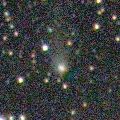
|
It brightened up to 11.5 mag in last summer (Aug. 4, Marco Goiato). Although it is not observable in the Northern Hemisphere, it keeps observable in good condition for a long time in the Southern Hemisphere. However, no visual observations have been reported since last summer. Recent CCD observations suggest that it is still visible visually around 12-13 mag.
Date(TT) R.A. (2000) Decl. Delta r Elong. m1 Best Time(A, h)
Apr. 18 3 54.20 -55 36.4 3.254 3.089 71 13.0 20:04 ( 40,-28)
Apr. 25 4 9.86 -53 8.8 3.305 3.127 71 13.0 20:11 ( 44,-29)
|

|
Since the major outburst in last September, with a new outburst in December, it has been so bright as 10-11 mag for about half a year. Now it is still bright as 11.5 mag (Mar. 26, Juan Jose Gonzalez).
Date(TT) R.A. (2000) Decl. Delta r Elong. m1 Best Time(A, h)
Apr. 18 7 44.09 22 51.3 6.112 6.122 85 13.8 20:04 ( 75, 60)
Apr. 25 7 46.41 22 39.5 6.225 6.124 79 13.9 20:11 ( 81, 53)
|
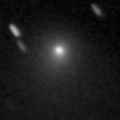
|
It reached to 10.9 mag in May (May 11, Marco Goiato). It is fading slowly. Now it is 13.7 mag (Mar. 22, Juan Jose Gonzalez), still visible visually. It keeps bright as 13-14 mag for a long time after this until summer.
Date(TT) R.A. (2000) Decl. Delta r Elong. m1 Best Time(A, h)
Apr. 18 16 47.74 30 21.0 3.391 3.985 119 13.9 3:04 ( 0, 85)
Apr. 25 16 45.14 31 57.0 3.413 4.032 121 13.9 2:34 ( 0, 87)
|
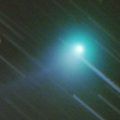
|
It reached to 6.3 mag in September in the southern sky (Sept. 4, Marco Goiato). Now it is fading, but still bright as 11.2 mag visually (Mar. 22, Juan Jose Gonzalez). It has already faded down to 15.0 mag by CCD observations (Mar. 11, Ken-ichi Kadota). It keeps observable in the northern sky while fading gradually. In the Southern Hemisphere, it will never be observable again.
Date(TT) R.A. (2000) Decl. Delta r Elong. m1 Best Time(A, h)
Apr. 18 22 42.15 67 4.9 3.364 3.058 63 13.9 3:55 (208, 37)
Apr. 25 23 0.96 69 23.6 3.451 3.136 63 14.1 3:44 (205, 37)
|

|
The condition of this return is bad, and it has not been observed yet. It will appear in the morning low sky at 13.5 mag in June. Then it will be getting higher gradually while fading slowly.
Date(TT) R.A. (2000) Decl. Delta r Elong. m1 Best Time(A, h)
Apr. 18 0 21.18 7 16.3 2.437 1.539 20 14.2 3:55 (258, -4)
Apr. 25 0 41.81 9 43.0 2.390 1.504 21 14.1 3:44 (256, -4)
|

|
Now it is 15.0 mag, brightening as expected (Mar. 29, G. W. Christie, T. Natusch). It is expected to brighten up to 12.5 mag in May and June. The condition is good in the Southern Hemisphere, and it keeps observable for a long time until August. In the Northern Hemisphere, it is only observable from mid June to mid August in the evening low sky.
Date(TT) R.A. (2000) Decl. Delta r Elong. m1 Best Time(A, h)
Apr. 18 21 14.41 -52 54.3 1.794 1.985 85 14.4 3:55 (330,-10)
Apr. 25 21 2.39 -55 41.6 1.607 1.950 93 14.1 3:44 (335, -9)
|
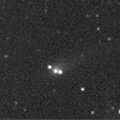
|
Now it is 13.2 mag and visible visually (Apr. 2, Marco Goiato). It will brighten up to 12-13 mag in 2010 summer. In 2009, it keeps observable in good condition until summer.
Date(TT) R.A. (2000) Decl. Delta r Elong. m1 Best Time(A, h)
Apr. 18 12 1.05 14 9.3 2.182 3.055 144 14.3 22:14 ( 0, 69)
Apr. 25 11 57.23 14 4.6 2.217 3.034 137 14.3 21:42 ( 0, 69)
|

|
Now it is 13.0 mag (Mar. 26, Juan Jose Gonzalez). It had been bright and visible visually around 13 mag from spring to autumn in 2008. It will be visible visually at 14 mag again until summer.
Date(TT) R.A. (2000) Decl. Delta r Elong. m1 Best Time(A, h)
Apr. 18 14 18.62 36 45.6 5.773 6.486 131 14.8 0:35 (180, 88)
Apr. 25 14 10.27 37 19.8 5.824 6.511 129 14.8 23:54 (180, 88)
|
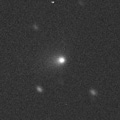
|
Now it is visible visually at 13.8 mag (Mar. 21, Jose Carvajal). It will be observable at 15 mag in good condition in spring.
Date(TT) R.A. (2000) Decl. Delta r Elong. m1 Best Time(A, h)
Apr. 18 11 40.54 8 44.6 1.489 2.374 143 14.9 21:53 ( 0, 64)
Apr. 25 11 35.69 7 33.1 1.530 2.363 136 14.9 21:21 ( 0, 62)
|
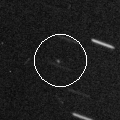
|
Brightened rapidly, and now it reached up to 15.5 mag (Apr. 3, Ken-ichi Kadota). It keeps 15 mag in April. It moves southwards very fast after early April, and will be unobservable very soon in the Northern Hemisphere.
Date(TT) R.A. (2000) Decl. Delta r Elong. m1 Best Time(A, h)
Apr. 18 21 24.33 17 24.2 0.268 0.914 63 15.1 3:55 (274, 38)
Apr. 25 21 46.38 5 51.3 0.286 0.924 65 15.2 3:44 (285, 30)
|
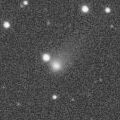
|
It brightened up to 12.7 mag in 2008 spring (Apr. 12, Marco Goiato). But it faded down to 14.9 mag in July (July 22, Mitsunori Tsumura). In the Southern Hemisphere, it will be observable in good condition after this. It will never be observable again in the Northern Hemisphere.
Date(TT) R.A. (2000) Decl. Delta r Elong. m1 Best Time(A, h)
Apr. 18 20 3.52 -50 5.9 3.558 3.782 95 15.2 3:55 (338, -1)
Apr. 25 20 9.46 -50 44.1 3.514 3.823 100 15.3 3:44 (340, -1)
|
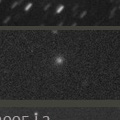
|
Now it is 16.2 mag (Mar. 31, Catalina Sky Survey). It will be brightening rapidly after this, and will be 10 mag in autumn. It keeps observable for a long time until 2010 February. But in the Northern Hemisphere, it will be lower than 20 degree after July when it becomes about 13 mag, then it keeps very low all through the brightest time. It locates a bit higher in the Southern Hemisphere.
Date(TT) R.A. (2000) Decl. Delta r Elong. m1 Best Time(A, h)
Apr. 18 12 46.22 0 19.0 1.252 2.228 161 15.7 22:58 ( 0, 55)
Apr. 25 12 38.82 0 49.4 1.236 2.182 153 15.5 22:23 ( 0, 56)
|

|
Now it is 14.5 mag and visible visually (Mar. 22, Juan Jose Gonzalez). It will be observable at 15-16 mag in good condition until spring.
Date(TT) R.A. (2000) Decl. Delta r Elong. m1 Best Time(A, h)
Apr. 18 9 6.91 23 54.1 3.197 3.576 104 15.6 20:04 ( 43, 75)
Apr. 25 9 9.62 23 32.3 3.292 3.574 97 15.6 20:11 ( 60, 70)
|
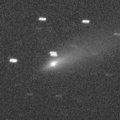
|
It reached up to 9.6 mag in summer (Aug. 2, Juan Jose Gonzalez). Now it is fading. But it is still reported very bright as 12.8 mag visually (Mar. 22, Juan Jose Gonzalez). But it has already faded down to 15.4 mag by CCD observations (Mar. 11, Ken-ichi Kadota). It keeps observable in good condition until June when it becomes fainter than 18 mag.
Date(TT) R.A. (2000) Decl. Delta r Elong. m1 Best Time(A, h)
Apr. 18 12 47.45 39 0.5 2.217 2.949 128 16.2 23:00 (180, 86)
Apr. 25 12 40.99 38 6.0 2.306 2.995 124 16.4 22:26 (180, 87)
|

|
It keeps 16 mag until late April. But it locates low in the Northern Hemisphere.
Date(TT) R.A. (2000) Decl. Delta r Elong. m1 Best Time(A, h)
Apr. 18 14 34.93 -24 39.9 1.916 2.886 161 16.2 0:52 ( 0, 30)
Apr. 25 14 24.58 -21 10.6 1.934 2.933 171 16.3 0:14 ( 0, 34)
|
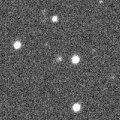
|
Although it had been low for a while, now it is getting higher. It will brighten up to 15 mag in 2009 and 2010, and will be observable for a long time in good condition.
Date(TT) R.A. (2000) Decl. Delta r Elong. m1 Best Time(A, h)
Apr. 18 21 47.48 32 10.5 3.642 3.228 58 16.4 3:55 (254, 39)
Apr. 25 21 46.47 34 26.6 3.524 3.193 62 16.3 3:44 (253, 43)
|
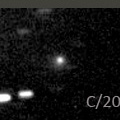
|
Now it is 16.4 mag (Mar. 14, Ken-ichi Kadota). It will be observable at 16.5 mag in good condition in 2009 spring.
Date(TT) R.A. (2000) Decl. Delta r Elong. m1 Best Time(A, h)
Apr. 18 15 52.06 36 25.7 2.477 3.150 124 16.7 2:09 (180, 89)
Apr. 25 15 30.32 36 45.1 2.469 3.174 126 16.7 1:20 (180, 88)
|

|
Now it is 14.7 mag and visible visually (Mar. 22, Juan Jose Gonzalez). It should have reached up to 14.5 mag in summer in the southern sky, but it is already fading. It keeps observable while the comet will be fading slowly after this.
Date(TT) R.A. (2000) Decl. Delta r Elong. m1 Best Time(A, h)
Apr. 18 11 15.99 -3 18.9 3.263 4.106 142 16.7 21:29 ( 0, 52)
Apr. 25 11 13.15 -1 36.5 3.389 4.159 134 16.8 20:58 ( 0, 53)
|

|
Peculiar asteroid moving along a cometary orbit. It will be observable around 17 mag in good condition for a long time until May. It will fade out very rapidly after May.
Date(TT) R.A. (2000) Decl. Delta r Elong. m1 Best Time(A, h)
Apr. 18 14 9.81 -3 4.2 1.237 2.233 169 16.7 0:27 ( 0, 52)
Apr. 25 14 2.41 -2 59.1 1.283 2.280 169 16.8 23:47 ( 0, 52)
|

|
Now it is 16.8 mag (Mar. 15, Ken-ichi Kadota). It will reach to 15 mag in 2010. It keeps observable for a long time after this in the Northern Hemisphere.
Date(TT) R.A. (2000) Decl. Delta r Elong. m1 Best Time(A, h)
Apr. 18 15 34.90 0 15.6 5.246 6.138 150 17.0 1:51 ( 0, 55)
Apr. 25 15 32.23 1 11.1 5.176 6.103 155 16.9 1:21 ( 0, 56)
|

|
Now it is 17.7 mag (Apr. 8, Yasukazu Ikari). It will brighten rapidly after this, and it is expected to be observable at 10-11 mag in a good condition for a long time from summer to winter.
Date(TT) R.A. (2000) Decl. Delta r Elong. m1 Best Time(A, h)
Apr. 18 20 44.60 -12 34.4 2.056 2.090 77 17.2 3:55 (309, 25)
Apr. 25 20 58.87 -11 54.6 1.928 2.032 81 16.9 3:44 (309, 26)
|

|
It will reach up to 14-15 mag from 2011 to 2012. Now it is 17 mag and locates low in the south.
Date(TT) R.A. (2000) Decl. Delta r Elong. m1 Best Time(A, h)
Apr. 18 15 36.68 -24 8.1 7.923 8.807 150 17.4 1:53 ( 0, 31)
Apr. 25 15 33.32 -24 19.1 7.834 8.772 157 17.4 1:22 ( 0, 31)
|
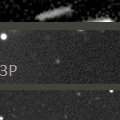
|
It reached 16.9 mag at opposition in March (Mar. 28, Ken-ichi Kadota). But it will fade out soon, and will be fainter than 18 mag in May.
Date(TT) R.A. (2000) Decl. Delta r Elong. m1 Best Time(A, h)
Apr. 18 11 49.07 -5 22.7 1.641 2.567 151 17.4 22:02 ( 0, 50)
Apr. 25 11 47.37 -4 52.4 1.678 2.560 143 17.5 21:33 ( 0, 50)
|
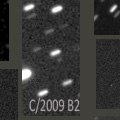
|
It will reach to 17 mag in March. But it will fade out soon, and will be fainter than 18 mag in May.
Date(TT) R.A. (2000) Decl. Delta r Elong. m1 Best Time(A, h)
Apr. 18 9 51.69 -3 16.9 1.682 2.372 121 17.6 20:04 ( 0, 52)
Apr. 25 9 33.73 -1 36.4 1.838 2.387 110 17.8 20:11 ( 22, 51)
|

|
Peculiar asteroid with a cometary orbit. It moves northwards very fast. It reaches up to 17 mag from late March to early April, however, it will fade out very soon.
Date(TT) R.A. (2000) Decl. Delta r Elong. m1 Best Time(A, h)
Apr. 18 9 56.40 -2 29.3 1.068 1.821 122 17.8 20:10 ( 0, 53)
Apr. 25 9 59.86 4 28.6 1.188 1.858 115 18.1 20:11 ( 13, 59)
|

|
Great outburst occured in 2007 October, and it bacame a naked eye comet of 2 mag. It kept so bright as 5.5 mag still in 2008 spring (Apr. 30, Carlos Labordena), but it was extremely faint and difficult to see. The size was so large, the diameter was larger than 60 arcmin. Now it became observable in good condition again. The extremely faint large diffuse glow may be detected with a best sky condition, around 5-6 mag with a diameter of 1 or 2 degrees. Mitsunori Tsumura detected a possible glow of Comet Holmes on Nov. 4. Current brightness of the central core is 17.7 mag (Feb. 13, Catalina Sky Survey), much brighter than pre-outburst brightness still now.
Date(TT) R.A. (2000) Decl. Delta r Elong. m1 Best Time(A, h)
Apr. 18 8 17.97 24 18.5 4.304 4.473 93 19.7 20:04 ( 68, 67)
Apr. 25 8 20.17 23 52.8 4.431 4.492 86 19.8 20:11 ( 76, 61)
|
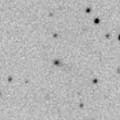
|
It was observed bright at 16.5-17 mag from late 2006 to early 2007. However, it is fading after that, although it is getting closer to the sun. It was so faint as 19.4 mag around the perihelion passage in 2008 spring (Mar. 10, Mitsunori Tsumura). This comet was observed so faint around the perihelion passage in the previous apparition at the discovery. It faded out before the perihelion passage again in this apparition. No observations have been reported since 2008 April at all. At least, it is fainter than 20 mag now (Mar. 15, Leonid Elenin).
Date(TT) R.A. (2000) Decl. Delta r Elong. m1 Best Time(A, h)
Apr. 18 11 20.82 24 35.4 3.727 4.443 130 22.2 21:34 ( 0, 80)
Apr. 25 11 19.34 24 24.6 3.812 4.452 123 22.3 21:05 ( 0, 79)
|
|
![]()
 C/2008 Q3 ( Garradd )
C/2008 Q3 ( Garradd ) 65P/Gunn
65P/Gunn C/2005 L3 ( McNaught )
C/2005 L3 ( McNaught ) 77P/Longmore
77P/Longmore 209P/2008 X2 ( LINEAR )
209P/2008 X2 ( LINEAR ) C/2007 B2 ( Skiff )
C/2007 B2 ( Skiff ) 88P/Howell
88P/Howell 74P/Smirnova-Chernykh
74P/Smirnova-Chernykh 19P/Borrelly
19P/Borrelly C/2009 F5 ( McNaught )
C/2009 F5 ( McNaught ) C/2008 N1 ( Holmes )
C/2008 N1 ( Holmes ) C/2008 Q1 ( Maticic )
C/2008 Q1 ( Maticic ) C/2006 U6 ( Spacewatch )
C/2006 U6 ( Spacewatch ) 2001 TX16
2001 TX16 C/2008 FK75 ( Lemmon-Siding Spring )
C/2008 FK75 ( Lemmon-Siding Spring ) 217P/2009 F3 ( LINEAR )
217P/2009 F3 ( LINEAR ) C/2009 F4 ( McNaught )
C/2009 F4 ( McNaught ) 143P/Kowal-Mrkos
143P/Kowal-Mrkos C/2009 B2 ( LINEAR )
C/2009 B2 ( LINEAR ) 2009 FW23
2009 FW23 17P/Holmes
17P/Holmes 173P/2005 T1 ( Mueller 5 )
173P/2005 T1 ( Mueller 5 )![]()































